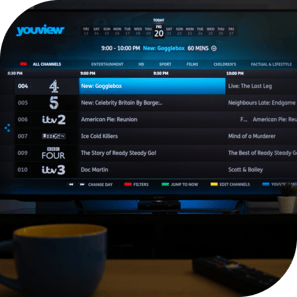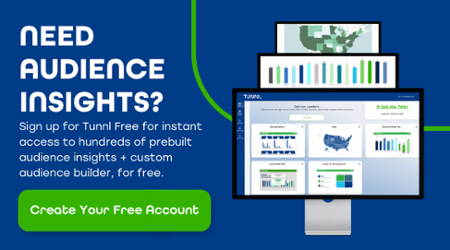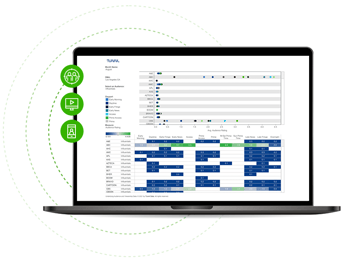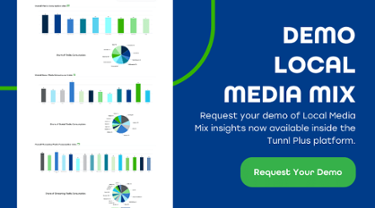Content-Centric vs. Audience-Based: The Most Accurate TV Ad Buying Method

You may have watched Meet the Press on Sunday. You’d be among anywhere from 2 to 4 million other viewers between the ages of 25 to 54 enjoying the longest-running, top-rated NBC interview news program.
.png?width=318&height=318&name=Blog%20article%20image%20(6).png) So with that many eyes on Meet the Press, is its runtime a smart slot for your TV ad campaign?
So with that many eyes on Meet the Press, is its runtime a smart slot for your TV ad campaign?
Unless you need to reach every single person between the ages of 25 and 54 whose interested in news and politics with your message - regardless of their location, sentiments, or lifestyle - it may not be a wise move. With a content-centric TV ad buying approach, you could choose primetime ad space to squeeze your message into popular programs like Meet the Press, hoping a large swath of your audience is watching. But you’d be broadcasting your message to a lot of people who are irrelevant to your efforts.
There’s an alternative, one Tunnl TV advertising pioneers have been innovating around for decades as competition increases in the linear broadcast space: audience-based advertising.
But what sets one approach apart from the other? Is there one true solution that will satisfy every advertiser’s desire to be heard over the noise? Both approaches have their merits. Let’s assess which might be right for you.
What’s the Difference Between Content-Centric TV Ad Buying and Audience-Based Advertising?
Audience-based and content-centric advertisers have the same ultimate goal: to reach the right people with their ads. While their methods may vary, it’s more a matter of putting the chicken before the egg or vice versa rather than two diametrically opposed approaches to advertising.
Content-centric advertisers choose when and where to place their TV ads based on a program’s content.
Audience-based advertisers choose when and where to place their TV ads based on who they need to reach and what content that group consumes.
“The difference here is that with content-centric TV ad buying, you're choosing the content for the content's sake,” says Adam McInturff, Tunnl’s Senior Manager of Business Development. “You're saying, ‘Hey, I think the people I care about might watch this sort of content, so I'm going to buy it.’
With an audience-based buying approach, you're choosing the content based on what your target audience consumes. It’s more like, ‘I know who we care about, and I know those people watch this content, so I'm going to buy it.’”
There’s merit to both approaches, as they both rely on some degree of audience intelligence to create an effective ad strategy. It’s the intensity of the audience intelligence that sets them apart. Since content-centric advertising puts less emphasis on audience research and insights, we’ll start there.
When Should I Use Content-Centric Advertising?
 The content-centric advertising approach is ideal for TV advertisers who want to reach a large, general demographic through popular television programming. Advertisers choose a program, like a morning news show or primetime drama, based on who they assume watches the show and place their ads to reach members of that audience accordingly.
The content-centric advertising approach is ideal for TV advertisers who want to reach a large, general demographic through popular television programming. Advertisers choose a program, like a morning news show or primetime drama, based on who they assume watches the show and place their ads to reach members of that audience accordingly.
It’s a popular method for linear and broadcast television advertisers because it allows them to reach large, diverse audiences in one swoop. But is it worth the hype? Is that really the best way to reach the right people?
Advantages of the Content-Centric Approach
There’s plenty to love about content-centric marketing, predominantly its convenience and consistency. For many TV advertisers, it offers a fast, safe way to get ads in front of large groups of potential customers, voters, and donors. Here’s how:
1. It’s easy.
 Since networks and broadcast companies can usually tell you a bit about their programs’ viewership, content-centric advertising can be relatively convenient. In one conversation, you can identify which programs are most popular with the demographic you’re targeting, or which shows’ subjects align with your offering, and purchase ad space accordingly.
Since networks and broadcast companies can usually tell you a bit about their programs’ viewership, content-centric advertising can be relatively convenient. In one conversation, you can identify which programs are most popular with the demographic you’re targeting, or which shows’ subjects align with your offering, and purchase ad space accordingly.
This one-stop-shop element makes content-centric marketing appealing to advertisers but isn’t always applicable. If you’re eyeing a particular media market but plan to network hop to encompass multiple programs, the process gets more clunky.
Nonetheless, you’re getting insights for your campaigns from the same place you buy ad space from, so your media planning and ad placement are substantially streamlined with a content-centric approach.
2. It’s a safe way to control your ad’s context.
Choose a scripted drama as the backdrop for your TV ad campaign, and you’ll generally know what you’re getting yourself into. Even varied programs like news shows or reality TV have fairly consistent themes you can count on.
Consistency is part of the appeal of content-centric advertising. Instead of having your ad land alongside goodness-knows-what, you have some control over its context. This is particularly crucial for cause-marketing or issue-based advertising campaigns that address sensitive or controversial subjects.
Buying ad space based on specific programs lends a sense of brand protection to your content-centric campaigns.
What You Need to Know Before Trying Content-Centric Marketing
So, what’s not to like about the content-centric approach? It’s certainly not perfect. The biggest issue with content-centric advertising is the guesses and gaps that go into its targeting methodology. And if your ads are off target, it can cost you.
1. You may waste money.
.png?width=215&height=215&name=Blog%20article%20image%20(8).png) There’s a lot of competition in TV advertising, and content-centric marketing is in the thick of it. Some programs draw a massive audience, attracting advertisers who want a share of that undivided attention. But as more advertisers compete for air time during popular programming, costs increase.
There’s a lot of competition in TV advertising, and content-centric marketing is in the thick of it. Some programs draw a massive audience, attracting advertisers who want a share of that undivided attention. But as more advertisers compete for air time during popular programming, costs increase.
You may be spending more money than you need to and only reaching a fraction of your audience.
“You're going to have substantial waste as you're going to reach a lot of people that you don't care about,” says Adam McInturff, Tunnl’s Senior Manager of Business Development. “You're also going to have to spend a lot more per impression to reach the people you do care about than if you did an audience-based approach.”
2. There’s a more efficient way to target your ads.
Content-centric marketing is great because it lets you reach a lot of people at once with the assumption that some of those viewers will want your product or align with your cause. However, casting a wide net with content-centric marketing is part of this approach’s downfall: you catch a lot of fish that don’t fit the bill.
“If you're doing a content-centric marketing campaign and you're buying Sunday morning news shows, you're actually leaving out large swaths of inventory where your audience is reachable, probably at a fraction of the cost, to compete for ad space on a program viewed by a lot of people outside your target audience,” says McInturff.
Instead of using content-centric marketing to target your ads based on broad, demographic-driven assumptions about who's watching, you could take a more strategic approach to finding your audience on TV and online.
The best way to do that? Audience-based advertising.
When Should I Use Audience-Based TV Ad Buying?
 It’s fair to say that content-centric marketers know a bit about their audience; they’d have to if they wanted to choose even vaguely appropriate programs to align their ads with. But the insights that content-centric advertising requires are typically demographic - things like sex, age, and maybe income or race. They don’t tell you much about what people think, believe, or do, and they aggregate to provide average viewership data; you’re not getting a complete picture this way.
It’s fair to say that content-centric marketers know a bit about their audience; they’d have to if they wanted to choose even vaguely appropriate programs to align their ads with. But the insights that content-centric advertising requires are typically demographic - things like sex, age, and maybe income or race. They don’t tell you much about what people think, believe, or do, and they aggregate to provide average viewership data; you’re not getting a complete picture this way.
Audience-based TV ad buying is the more in-depth answer to content-centeric marketing because it puts the utmost importance on understanding your target audience first and foremost before choosing TV ad space. That’s a large part of why savvy advertisers gravitate toward the audience-based approach.
Advantages of Audience-Based TV Ad Buying
Knowledge is power, right? The more you know about your audience, the more exact your campaigns will be. Precision and certainty make this method appealing, so let’s unpack how they are achieved through audience-based TV ad buying.
1. It’s more precise.
As mentioned, audience-based advertising puts a strong emphasis on knowing everything you can about your target audience before planning the other elements of your media buy. This means going beyond demographic information to identify what issues, causes, and topics your ideal segment cares about. Once you’ve found a group that aligns with your campaign, you can then determine how they consume media on a regular basis.
Tunnl Tip: Use Tunnl’s prebuilt audience library to browse hundreds of issue-based audiences and analyze media mix data for your selected segment. It’s a fast, accurate way to determine which platforms and mediums are most popular with your target audience on a local and national level.
The intention of audience-based TV ad buying is to find the most efficient combination of ad spaces for reaching your motivated, aligned audience without overspending. We’ll get more into the budgetary benefits of this more precise approach in a second, but remember this:
Content-centric advertising casts a wide net. Audience-based advertising is more like spearfishing.
2. It eliminates costly guesswork.
Part of the problem with content-centric advertising is how many assumptions you have to rely on to choose the best programs for reaching your audience. And every guess you make can force you into spending more because you’re missing hidden opportunities to connect with your target segment in less competitive spaces.
With the precise audience insights we mentioned earlier, unearthing those budget-maximizing opportunities is extremely easy, and you can trust that you’re making data-backed decisions for your campaigns.
“What matters is who you're reaching, not where you're reaching them,” says McInturff. “Instead of guessing that your target audience is going to watch a single popular program, use our data to know what they watch. If the data reveals that your audience watches that popular program, then, great, buy it.
But if they watch other stuff, you're probably going to be able to reach them more effectively and more efficiently for fewer dollars because all the other advertisers are competing for the inventory on that popular program.
So let everyone else go fight over that ad space, and you go find your audience where they're more available somewhere else for a fraction of the cost.”
Audience insights give you data-backed proof of what other advertisers are (probably inaccurately) guessing about. But how hard is it to acquire that insider information?
3. It’s just as easy as content-centric advertising.
Adopting a new process is usually a hard sell, especially when your current ad placement process is so simple. You know you want to launch a TV campaign, so you reach out to the station or broadcast company, pick their brain about who watches what, and boom. The ad space is yours. Easy, right?
You won’t be giving up that convenience if you switch to audience-based TV ad buying; you’ll simply have more data to leverage when you enter those conversations.
But isn’t audience research difficult? Sure. It can cost millions of dollars, take months to organize, and you’ll need expensive data experts to make sense of all the information before you can use it. 
Or, you can use an audience intelligence platform like Tunnl, which aggregates survey data into curated issue-based audiences - broken down by demographics, media consumption behaviors, and more - for you. Then it’s done in minutes, could cost you little to nothing, and all the complicated data compliance elements are securely handled for you.
More audience insights with minimal extra work. It is simplicity itself.
So, audience-based advertising is more accurate, more efficient, and still easy if you have tools like Tunnl? The audience-based approach can sound too good to be true, but like everything else, it has catches that may be easier to overcome for some advertisers than others.
What You Need to Know Before Trying Audience-Based TV Ad Buying
There are no major red flags that will stand between you and audience-based advertising. You will need to assess your resources, though, and put a bit of effort into establishing a reliable process and tech stack for acquiring audience intelligence. Consider this:
1. Where you get your audience data makes a big difference.
Audience intelligence is its own industry. There are dozens of data providers eager to enable your audience-based buys who use different data types, insights, and data collection methods to help you.
But they are not all created equally.
Before you build your campaign around audience data from any provider, vet their data collection process and inquire about how they build audiences. Make sure their data is refreshed on a regular basis so you’re not using outdated insights to reach a rapidly changing audience.
How does Tunnl provide the industry’s best data? Glad you asked!
We conduct surveys throughout the country to measure people’s opinions on critical issues across the social, corporate, environmental, and recreational spectrum.
Combining anonymized voter and consumer files, a proprietary AI-powered data modeling process, and the survey data we collect, we create hundreds of prebuilt and custom audience solutions for advertisers like you. They all get updated monthly, so you’re always reaching the right audience.
Be thorough in your assessment of a third-party audience data provider. You have plenty of options specializing in various niches and offered at a range of price points, so you’ll have a lot to dig into. But it’s worth the work. The last thing you want is to invest in unreliable, unsafe data that diminishes your campaign’s impact because audience data will cost you.
2. You should budget for audience data.
Some of the best things in life may be free, but accurate audience data is not usually one of them. Actionable in-depth insights, like which linear TV programs rank the highest among your target audience, require a Tunnl subscription to access.
 The same goes for most of our competitors. Think back to what we said earlier about what goes into gathering audience intelligence. It can cost a lot of money to coordinate a national survey, not to mention the costs associated with securely storing, managing, and updating that data over time. Tack on data engineers that turn survey responses into targetable audiences for advertisers, and the overhead of audience research gets higher and higher.
The same goes for most of our competitors. Think back to what we said earlier about what goes into gathering audience intelligence. It can cost a lot of money to coordinate a national survey, not to mention the costs associated with securely storing, managing, and updating that data over time. Tack on data engineers that turn survey responses into targetable audiences for advertisers, and the overhead of audience research gets higher and higher.
The price you’ll pay for accurate, complaint, secure audience data from an audience intelligence provider is still a minuscule fraction of what it would cost to collect that information yourself.
But nonetheless, acquiring reliable insights is likely to dip into your ad or marketing budget. Factor them into your budget if you hope to use an audience-based buying approach.
What’s important to remember when weighing the cost of third-party audience data is how much budget efficiency accurate targeting can ensure. With more accurate insights leading to less waste, your ad dollars can be maximized on campaigns that reach precisely the right audience to create action, prompt purchases, and raise awareness.
Maximize Your Ad Budget with Audience-First Ad Targeting
There is no right or wrong way to plan your TV ad buys, but some strategies are more efficient and targeted than others. When it comes to weighing content-centric marketing against audience-based TV ad buying, we believe you don’t have to choose one over the other.
The most effective content-centric ad buying decisions are led by an audience-based approach.
After all, the way we buy TV ad space is still rooted in time and place. You still need to decide which programs to target, justifying a content-centric mindset. Data-backed audience insights simply make your placement decisions easier, especially when you’re armed with national or local media mixes, Tunnl’s Cable Ranker feature, and media measurement tools.
There’s no need to reinvent the wheel when it comes to TV ad buys, but introducing thorough, reliable audience insights is bound to give you more traction.




